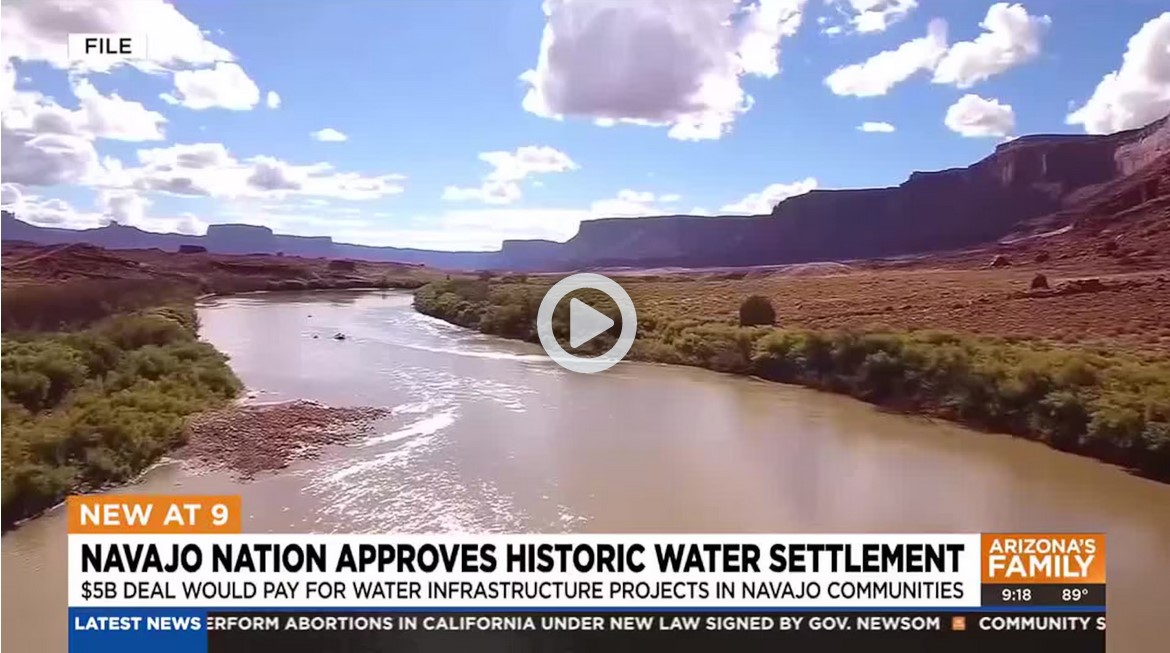
Arizona Colorado River Update
The Kyl Center for Water Policy introduces a new blog series featuring updates on Colorado River, groundwater and other water policy issues in Arizona. The next two years will be pivotal as stakeholders negotiate the reservoir operating rules that dictate Colorado River shortages in our state, and these shortages will impact our groundwater. We will try to bring some clarity through light-hearted updates featuring a movie theme. We hope you enjoy it!
The Good, the Bad and the Ugly
News: The Bureau of Reclamation just released its latest Five-Year Probabilistic Projections of future conditions in the Colorado River system.
The good: Two years of good snowpack have bought time. Water levels in Lakes Powell and Mead rose considerably due to this snowpack, lowering the chances that water levels in these reservoirs will plummet to disastrous levels in the next few years. Combined with intentional management strategies to use less water in the Lower Basin, the runoff from favorable snowpack has averted short-term crisis on the Colorado River system. Whew!
The bad: The Colorado River system is volatile and water levels in its reservoirs are heavily dependent on starting conditions for the year. Because water levels are still at historic lows, all it takes is one bad year of snowpack for things to look pretty terrible again.
The ugly: Through involuntary cuts, voluntary contributions to Lake Mead and compensated System Conservation efforts, Central Arizona has relinquished about half of its Colorado River water through 2026. This means the Lower Basin is going through its dry powder (its easily utilized opportunities). If snowpack is very low in the next year or two, the management-side tools left in the storeroom to confront falling lake levels will be more painful to deploy.
The silver lining: Arizonans are good preparers! Shortage has encouraged municipal water providers in Central Arizona to further develop alternative water supplies and dig even deeper with conservation efforts.

News: There may be some problems at Glen Canyon Dam.
The good: The largest reservoirs in the U.S.—Lakes Powell and Mead—are operating as intended. Reservoirs are designed to capture and store water when runoff is plentiful so that the water can be used in subsequent dry years. Water users depleted Powell and Mead during dry times but the reservoirs have captured runoff from recent bonus snowpack.
The bad: No matter what the snowpack, the Colorado River system remains over-allocated, meaning that water users are entitled to more water from the river than it can reliably provide over time. Without bonus precipitation nearly every year or relatively permanent cuts of around two million acre-feet per year basin-wide, it is likely that reservoir levels will continue to be problematic.
The ugly: Below elevation 3,490’ in Lake Powell, water must pass through river outlet tubes instead of spillways. The Bureau of Reclamation has discovered problems with Lake Powell’s river outlet tubes and has concluded that it cannot rely on these outlets to move water from Lake Powell to Lake Mead for long periods of time. Infrastructure. It is always about the infrastructure! At worst, this may mean the Bureau must protect elevation 3,490’ and thus could result in severe restrictions on the amount of water that is delivered from Lake Powell to Lake Mead. If this is the case, there may be very deep shortages in the Lower Basin.
The silver lining: Water lawyers had to learn what “cavitation” means. No, seriously, there is no silver lining here.

News: The Bureau of Reclamation has released various tedious but important documents associated with National Environmental Policy Act compliance as it relates to management of the Colorado River system.
The good: Despite its many shortfalls, the legal framework of the Colorado River basin has held during a period of extreme system stress, and has provided enough flexibility to avoid catastrophic outcomes through 20+ years of the worst drought in around 1,200 years. That is huge. The Bureau’s documents are a continuation of the application of this legal framework to addressing big issues on the Colorado River system.
The bad: The guidelines for operation of Lakes Powell and Mead expire at the end of 2026. Beyond then, the timing, duration, and depth of shortages in the Lower Basin are unknown. This uncertainty is hugely problematic for the majority of tribes and municipal water providers in Central Arizona, who rely on the lowest priority water in the Lower Basin for tap water, aquifer recharge, farming and other purposes.
The ugly: Stakeholder conversations about a post-2026 path appear to be stalled, and anyway, seemingly somewhat dysfunctional when they do occur. Forget snowpack—the real uncertainty is how the legal framework is stretched, altered, improved or destroyed post-2026.
The silver lining: Despite being left out of compact negotiations in 1922, tribes in Arizona are playing a larger role than ever in Colorado River management and negotiations. The Colorado River Indian Tribes have the largest and most senior water right on the mainstem in Arizona and the Gila River Indian Community has the largest allocation in Central Arizona. What these two tribes do may matter as much as the collective actions of every other stakeholder in the state.

Image Source: Arizona Family
News: The Councils of the Hopi Tribe, Navajo Nation and San Juan Southern Paiute Tribe approved the Northeastern Arizona Water Rights Settlement.
The good : Settlement of water rights claims among these tribes and the numerous non-tribal towns, farmers, ranchers, industries and homeowners who all share the Lower Colorado River watershed would provide all stakeholders with the certainty necessary to move forward with water resource and community development plans. The Navajo and Hopi communities already have access to the groundwater and surface water within their reservations, but they would gain access to 47,000 acre-feet of Upper Basin Colorado River mainstem water and money to build the infrastructure for delivery of the water to communities within their homelands. The San Juan Southern Paiute would gain a federally recognized reservation and the right to be served water from the Navajo Tribal Utility Authority at the same price as is charged to Navajo customers.
The bad: The settlement allows the Navajo and Hopi’s 47,000 acre-feet of Colorado River water from the Upper Basin to be used in the Lower Basin—which is great from a Lower Basin perspective—and a much smaller amount (around 4,000 acre-feet) of Navajo Lower Basin water to be used in New Mexico and Utah. Colorado might not like this so much, but lately Colorado's water negotiators have been making big statements about standing with tribes.
The ugly: There is still a long road to travel, as the settlement must be approved by Congress and the price tag—$5 billion—is the largest ever for a tribal water rights settlement. Getting anything through Congress these days is…um…yeah. Horse trading is to be expected, but will there be a poison pill?
The silver lining: Though it is a ways off, at some point all of these tribes, farmers, ranchers and other stakeholders will not need to pay so much to water lawyers and can spend the money on mending fences instead, both literally and figuratively.
 News: The federal government is throwing money at nearly everyone in the Lower Basin.
News: The federal government is throwing money at nearly everyone in the Lower Basin.
The good: Due to this money and other factors, we have managed to keep a sizeable amount of water in Lake Mead to forestall deeper shortages.
The bad: The vast majority of this water is assigned water that was voluntarily left in Lake Mead—meaning that it belongs to someone who has the right, under certain reservoir conditions, to take the water out of Lake Mead independent of the existing priority system. This matters because when the assigned water is subsequently removed, we are all at square one again filling the hole—or worse—potentially filling a more problematic one depending on Lake Mead’s water levels when the assigned water is removed. Removal of assigned water at 1,075 is tough for other users, but removal of assigned water at 1,045 is much, much worse.
The ugly: Most of the water from Arizona’s apportionment that was left in Lake Mead was water that otherwise would have been used to recharge or replenish aquifers in Central Arizona. This points to what we have been saying all along—the main impact of shortage in Central Arizona will play out in long-term aquifer depletion.
The silver lining: Tribes, farmers, cities and private water companies in Arizona with a Colorado River right or entitlement participated in programs to leave water in Lake Mead, which signals that we can all get along when enough money is involved.

News: The Kyl Center for Water Policy has many tools that can help you understand and navigate these issues!
Try our Colorado River Story Map, which explains all things shortage in Arizona.
Read our paper on Colorado River Shortage Impacts to Tap Water Deliveries in Central Arizona, which details where major water providers get their tap water and how they will continue to meet tap water needs under shortage conditions. Our Shortage Impact Calculators may also be helpful.
Explore our paper on Groundwater Protection in the Valley of the Sun, that details how aquifers in the Phoenix area will be impacted by Colorado River shortage.
We need to deploy more management-side solutions, and many of those are dependent on land-use choices. Explore our story map on Water and Land Use in Central Arizona.